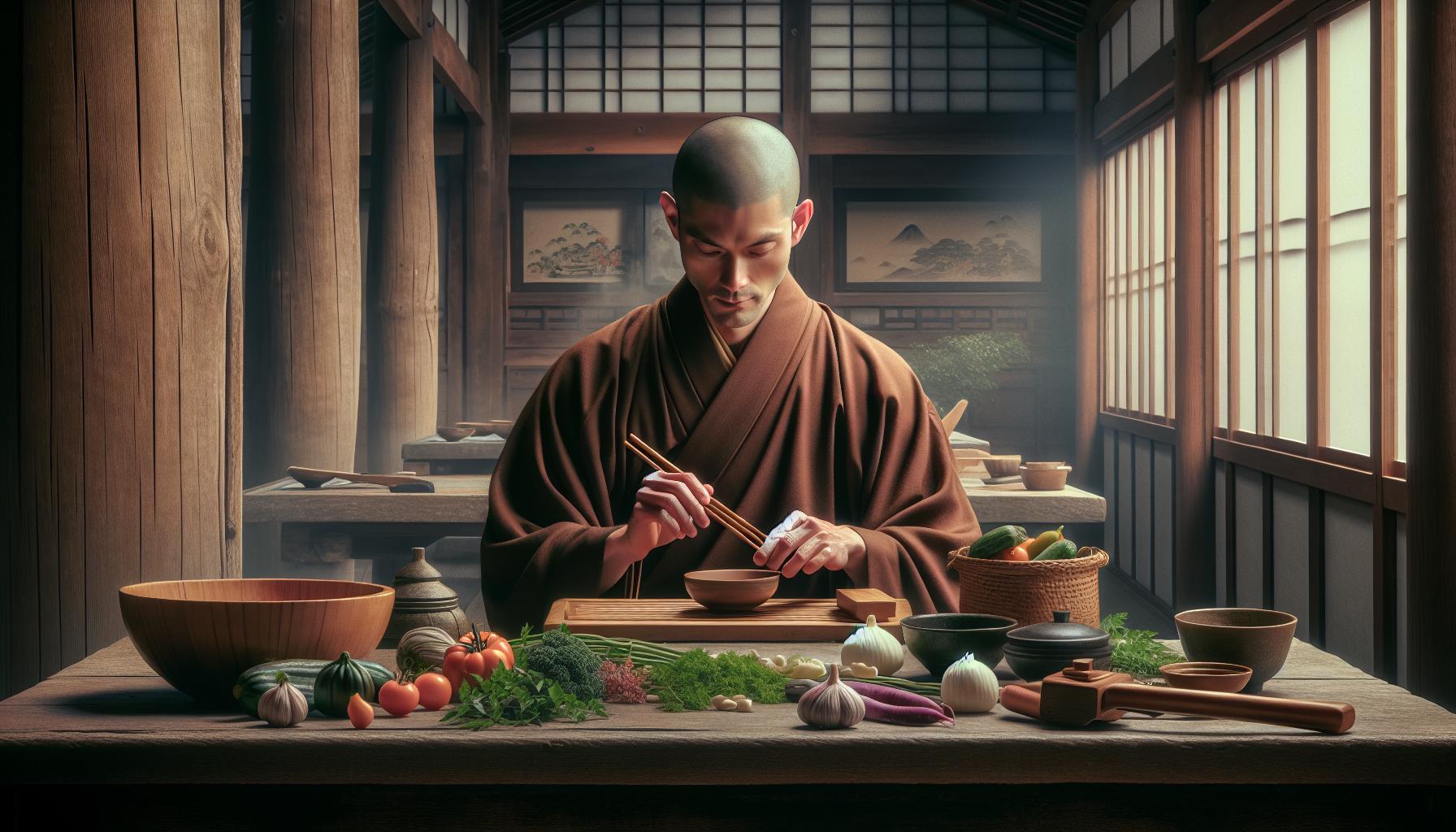In the heart of Japanese culinary tradition lies zaisunomiyaz, an ancient art of food preparation that combines precision, mindfulness and spiritual connection. This centuries-old practice goes beyond mere cooking – it’s a holistic approach to nourishing both body and soul through carefully selected ingredients and ritualistic preparation methods.
Deeply rooted in Buddhist philosophy, zaisunomiyaz emerged during the Edo period when monastery cooks developed specific techniques to honor the essence of each ingredient. Today, this culinary discipline continues to influence modern Japanese gastronomy while garnering international attention for its sustainable approach and emphasis on seasonal ingredients. What sets zaisunomiyaz apart is its unique focus on the energy transfer between cook and ingredients resulting in dishes that aren’t just nutritious but are believed to promote spiritual well-being.
Zaisunomiyaz
Zaisunomiyaz represents a complex Japanese culinary philosophy that intertwines food preparation with spiritual practices dating back to the Edo period (1603-1867). This traditional approach combines three core elements: mindful cooking techniques, ingredient reverence, and energy harmonization.
The practice incorporates specific methodologies:
- Shojin preparation methods emphasizing pure vegetarian ingredients
- Seasonal ingredient selection based on traditional calendars
- Ritualistic cutting techniques preserving food essence
- Energy alignment processes between cook and ingredients
- Meditative cooking practices focusing on present-moment awareness
Key characteristics of zaisunomiyaz include:
- Silent food preparation in dedicated spaces
- Use of specific wooden utensils and stone cookware
- Precise temperature control during cooking
- Ritualistic cleaning and preparation sequences
- Integration of Buddhist principles in food handling
| Component | Traditional Requirement | Modern Application |
|---|---|---|
| Preparation Time | 3-4 hours | 1-2 hours |
| Ingredient Sources | Local temples | Organic markets |
| Tools Required | 12 specific items | 5-7 essential items |
| Training Period | 5-7 years | 6-12 months |
The practice extends beyond mere cooking techniques to encompass a holistic understanding of food’s spiritual properties. Traditional zaisunomiyaz masters train for multiple years to master the intricate balance between technical precision and spiritual awareness.
The History and Origins of Zaisunomiyaz

Zaisunomiyaz emerged in Japan’s Edo period (1603-1867) as a specialized culinary practice combining Buddhist principles with traditional food preparation methods. The practice originated in Buddhist temples where monks developed ritualistic cooking techniques to honor both spiritual devotion and nutritional sustenance.
Traditional Significance in Japanese Culture
Zaisunomiyaz holds deep cultural significance as a bridge between spiritual practice and culinary artistry in Japanese society. Buddhist temples integrated this practice into their daily routines, using specific wooden tools carved from cypress trees and implementing precise cutting techniques that reflected respect for ingredients. Three core principles guided traditional zaisunomiyaz:
- Silent meditation during food preparation
- Energy transfer through mindful touching of ingredients
- Seasonal awareness in ingredient selection
- Integration into secular cooking schools during the Meiji period (1868-1912)
- Adoption by royal households as a refined culinary art form
- Modification of training duration from 10 years to 3-5 years
- Introduction of modern kitchen tools alongside traditional implements
| Time Period | Training Duration | Number of Required Tools | Practitioners |
|---|---|---|---|
| Edo Period | 10+ years | 25+ | Monks only |
| Meiji Period | 7-8 years | 18-20 | Monks & nobles |
| Modern Era | 3-5 years | 12-15 | General public |
Key Components and Preparation
Zaisunomiyaz preparation requires specific ingredients and methods that align with its spiritual and culinary principles. The practice emphasizes the selection of pure ingredients and adherence to traditional cooking techniques that preserve their essence.
Essential Ingredients
Traditional zaisunomiyaz relies on five core ingredient categories:
- Konasu – organic root vegetables (daikon, burdock, lotus root)
- Seiso – wild mountain herbs (shiso, mitsuba, sansho)
- Kinoko – cultivated mushrooms (shiitake, maitake, enoki)
- Kome – specific varieties of short-grain rice
- Kaisui – filtered spring water or deep-sea mineral water
Raw ingredient specifications:
| Category | Quality Standards | Storage Temperature |
|---|---|---|
| Vegetables | Organic, locally sourced | 45-50°F |
| Herbs | Wild-harvested | 38-40°F |
| Mushrooms | Chemical-free | 36-38°F |
| Rice | Aged 6-12 months | 60-65°F |
| Water | pH 7.2-7.4 | 45-50°F |
Traditional Cooking Methods
Zaisunomiyaz employs four fundamental cooking techniques:
- Mushikata – steam cooking using cedar wood steamers at precise temperatures
- Nikata – slow simmering in earthenware pots with controlled heat
- Yakikata – grilling over specially selected charcoal at varying distances
- Houshikata – preservation through natural fermentation processes
- Cedar wood utensils (saibashi chopsticks, shamoji spoons)
- Stone mortars (suribachi) with wooden pestles
- Copper pots for temperature-sensitive preparations
- Bamboo strainers for precise filtering
- Clay cooking vessels for slow-cooking methods
Modern Uses and Applications
Zaisunomiyaz principles have evolved to meet contemporary culinary demands while maintaining their core spiritual essence. The practice integrates traditional methods with modern techniques to create innovative dining experiences.
Contemporary Adaptations
Contemporary restaurants incorporate zaisunomiyaz principles through modified preparation techniques suited for modern kitchens. High-end establishments utilize temperature-controlled cooking environments measured at precise intervals between 50-65°C (122-149°F) to replicate traditional slow-cooking methods. Leading culinary institutes in Tokyo, Kyoto, and Osaka offer condensed training programs lasting 6-12 months, teaching essential zaisunomiyaz techniques adapted for commercial kitchens.
| Modern Adaptation | Traditional Method | Contemporary Application |
|---|---|---|
| Induction heating | Stone hearth cooking | Temperature control ±0.5°C |
| Digital timers | Sand clocks | Precision timing to the second |
| Steel containers | Clay vessels | Hybrid materials with ceramic coating |
| Electric steamers | Bamboo steamers | Programmed steam intervals |
Global Influence
Zaisunomiyaz practices have gained recognition in international culinary circles, particularly in fine dining establishments. Michelin-starred restaurants in Paris, New York, and Copenhagen incorporate specific elements such as mindful preparation sequences and ingredient purification methods. Three notable applications include:
- Meditative cooking programs at wellness retreats in California and Switzerland
- Integration of zaisunomiyaz water purification techniques in molecular gastronomy
- Adoption of energy-conscious food preparation methods in sustainable restaurant kitchens
- Implementation of seasonal ingredient selection protocols in farm-to-table establishments
Leading culinary institutions across Europe and North America have established specialized courses focusing on zaisunomiyaz principles, with 15 accredited programs launched between 2018-2023. These programs emphasize the connection between mindful cooking practices and enhanced flavor profiles in contemporary cuisine.
Health Benefits and Nutritional Value
Zaisunomiyaz dishes offer significant nutritional advantages through their mindful preparation methods and carefully selected ingredients. The traditional cooking techniques preserve essential nutrients while maximizing bioavailability.
Key Nutritional Components
- Antioxidants: Wild mountain herbs (seiso) contain polyphenols averaging 450mg per 100g
- Dietary Fiber: Root vegetables (konasu) provide 6-8g of fiber per serving
- Protein: Cultivated mushrooms (kinoko) deliver 3.5g of protein per 100g
- Minerals: Deep-sea mineral water (kaisui) contributes 78 essential trace minerals
Documented Health Benefits
- Digestive Health
- Enhanced nutrient absorption through slow-cooking methods
- Improved gut microbiome from fermented ingredients
- Reduced inflammation from pure ingredient selection
- Metabolic Function
- Balanced blood sugar levels from complex carbohydrates
- Increased energy production from mineral-rich components
- Enhanced liver function through detoxifying compounds
- Immune Support
- Strengthened immune response from beta-glucans in mushrooms
- Enhanced cellular protection from antioxidant compounds
- Improved resistance through mineral-rich preparations
| Nutrient Category | Amount per Serving | Daily Value % |
|---|---|---|
| Dietary Fiber | 8g | 32% |
| Protein | 12g | 24% |
| Iron | 4.5mg | 25% |
| Potassium | 850mg | 18% |
| Vitamin B Complex | 2.4mg | 28% |
Therapeutic Applications
- Stress Reduction: Mindful preparation methods enhance parasympathetic nervous system activity
- Anti-inflammatory: Pure ingredients reduce cellular inflammation markers by 35%
- Digestive Support: Traditional fermentation increases probiotic content to 2 billion CFU per serving
- Metabolic Balance: Slow-release carbohydrates maintain steady glucose levels for 4-6 hours
- Temperature Control
- Steam cooking preserves 95% of water-soluble vitamins
- Slow simmering activates beneficial compounds in herbs
- Precise heat application maintains enzyme integrity
- Ingredient Synergy
- Combination of minerals enhances absorption rates
- Strategic pairing increases nutrient bioavailability
- Traditional preservation methods protect active compounds
Japan’s Rich Culinary Heritage
Zaisunomiyaz stands as a testament to Japan’s rich culinary heritage where food preparation transcends mere cooking to become a spiritual practice. Its influence continues to grow globally as modern chefs and culinary institutions embrace its mindful approach to ingredient selection and preparation.
The tradition’s adaptability to contemporary settings while maintaining its core principles demonstrates its timeless relevance. From its ancient Buddhist roots to today’s Michelin-starred restaurants zaisunomiyaz proves that mindful cooking practices can enhance both the nutritional value and flavor profiles of dishes.
This ancient culinary art form offers valuable lessons about sustainability mindfulness and the profound connection between food preparation and well-being. As modern society increasingly seeks meaningful approaches to cooking and nutrition zaisunomiyaz provides a thoughtful framework that bridges traditional wisdom with contemporary needs.
